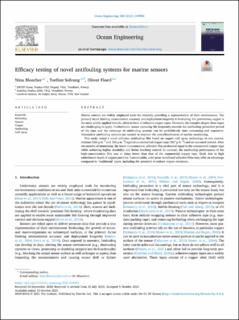| dc.contributor.author | Bloecher, Nina | |
| dc.contributor.author | Solvang, Torfinn | |
| dc.contributor.author | Floerl, Oliver | |
| dc.date.accessioned | 2021-10-18T09:18:36Z | |
| dc.date.available | 2021-10-18T09:18:36Z | |
| dc.date.created | 2021-10-15T11:49:28Z | |
| dc.date.issued | 2021 | |
| dc.identifier.issn | 0029-8018 | |
| dc.identifier.uri | https://hdl.handle.net/11250/2823615 | |
| dc.description.abstract | Marine sensors are widely employed tools for remotely providing a representation of their environment. The primary factor limiting measurement accuracy and deployment longevity is biofouling. For prevention, copper is the most widely applied biocide, often in form of adhesive copper tapes. However, for complex shapes these tapes are challenging to apply. Furthermore, sensor operating life frequently exceeds the antifouling protective period of the tape and the exchange of antifouling systems can be prohibitively time consuming and expensive. Alternative antifouling systems are needed to improve the cost-effectiveness of marine monitoring. This study tested a novel adhesive antifouling film based on copper cold spray technology in two concentrations (586 g m−2 and 306 g m−2) against a commercial copper tape (367 g m−2) and an uncoated control. After ten months of immersion, the lower concentration adhesive film performed equal to the commercial copper tape while achieving higher durability and better leaching control. In contrast, the antifouling performance of the high-concentration film was at times lower than that of the commercial copper tape, likely due to high embedment depth of copper particles. Customizable, cold spray metallised adhesive films may offer an advantage compared to ‘traditional’ tapes, including the potential to reduce copper emissions. | en_US |
| dc.language.iso | eng | en_US |
| dc.publisher | Elsevier | en_US |
| dc.rights | Navngivelse 4.0 Internasjonal | * |
| dc.rights.uri | http://creativecommons.org/licenses/by/4.0/deed.no | * |
| dc.subject | Cold spray | en_US |
| dc.subject | Antifouling | en_US |
| dc.subject | Copper | en_US |
| dc.subject | Sensors | en_US |
| dc.subject | Biofouling | en_US |
| dc.title | Efficacy testing of novel antifouling systems for marine sensors | en_US |
| dc.type | Peer reviewed | en_US |
| dc.type | Journal article | en_US |
| dc.description.version | publishedVersion | en_US |
| dc.rights.holder | © 2021 The Authors. Published by Elsevier Ltd. This is an open access article under the CC BY license | en_US |
| dc.source.pagenumber | 5 | en_US |
| dc.source.volume | 240 | en_US |
| dc.source.journal | Ocean Engineering | en_US |
| dc.identifier.doi | 10.1016/j.oceaneng.2021.109983 | |
| dc.identifier.cristin | 1946173 | |
| dc.relation.project | Fiskeri- og havbruksnæringens forskningsfinansiering: 901289 | en_US |
| dc.source.articlenumber | 109983 | en_US |
| cristin.ispublished | true | |
| cristin.fulltext | original | |
| cristin.qualitycode | 1 | |

